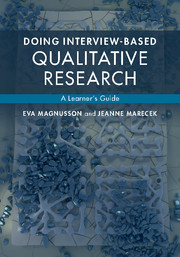Book contents
- Frontmatter
- Contents
- 1 Introduction
- 2 Some examples of interpretative research
- 3 Planning and beginning an interpretative research project
- 4 Making decisions about participants
- 5 Designing the interview guide
- 6 Doing the interview
- 7 Preparing for analysis
- 8 Finding meanings in people's talk
- 9 Analyzing stories in interviews
- 10 Analyzing talk-as-action
- 11 Analyzing for implicit cultural meanings
- 12 Reporting your project
- Epilogue
- References
- Index
5 - Designing the interview guide
Published online by Cambridge University Press: 05 October 2015
- Frontmatter
- Contents
- 1 Introduction
- 2 Some examples of interpretative research
- 3 Planning and beginning an interpretative research project
- 4 Making decisions about participants
- 5 Designing the interview guide
- 6 Doing the interview
- 7 Preparing for analysis
- 8 Finding meanings in people's talk
- 9 Analyzing stories in interviews
- 10 Analyzing talk-as-action
- 11 Analyzing for implicit cultural meanings
- 12 Reporting your project
- Epilogue
- References
- Index
Summary
This chapter shows you how to prepare a comprehensive interview guide. You need to prepare such a guide before you start interviewing. The interview guide serves many purposes. Most important, it is a memory aid to ensure that the interviewer covers every topic and obtains the necessary detail about the topic. For this reason, the interview guide should contain all the interview items in the order that you have decided. The exact wording of the items should be given, although the interviewer may sometimes depart from this wording. Interviews often contain some questions that are sensitive or potentially offensive. For such questions, it is vital to work out the best wording of the question ahead of time and to have it available in the interview.
To study people's meaning-making, researchers must create a situation that enables people to tell about their experiences and that also foregrounds each person's particular way of making sense of those experiences. Put another way, the interview situation must encourage participants to tell about their experiences in their own words and in their own way without being constrained by categories or classifications imposed by the interviewer. The type of interview that you will learn about here has a conversational and relaxed tone. However, the interview is far from extemporaneous. The interviewer works from the interview guide that has been carefully prepared ahead of time. It contains a detailed and specific list of items that concern topics that will shed light on the researchable questions.
Often researchers are in a hurry to get into the field and gather their material. It may seem obvious to them what questions to ask participants. Seasoned interviewers may feel ready to approach interviewing with nothing but a laundry list of topics. But it is always wise to move slowly at this point. Time spent designing and refining interview items – polishing the wording of the items, weighing language choices, considering the best sequence of topics, and then pretesting and revising the interview guide – will always pay off in producing better interviews. Moreover, it will also provide you with a deep knowledge of the elements of the interview and a clear idea of the intent behind each of the items. This can help you to keep the interviews on track.
- Type
- Chapter
- Information
- Doing Interview-based Qualitative ResearchA Learner's Guide, pp. 46 - 57Publisher: Cambridge University PressPrint publication year: 2015
- 7
- Cited by

